This article is about the japanese prefecture and its city. For other uses, see Tokyo ( disambiguation )
Metropolis in Kantō, Japan
Reading: Tokyo – Wikipedia
Tokyo english pronunciation : /toʊkiːjoʊ/ ( japanese : 東京, Tōkyō [ toːkʲoː ] ( ) ), historically known in the west as Tokio and formally the Tokyo Metropolis ( 東京都, Tōkyō-to ), is the capital, the largest city and the most populous metropolitan area in the Greater Tokyo Area, the Kantō region and Japan, ampere well as the most metropolitan in the universe. [ 7 ] and most populous prefecture of Japan. Located at the mind of Tokyo Bay, the prefecture forms region of the Kantō area on the central Pacific coast of Japan ‘s independent island of Honshu. Tokyo is the political and economic center of the state, ampere well as the induct of the Emperor of Japan and the national government. As of 2021, the prefecture has an estimated population of 14.04 million. [ 4 ] The Greater Tokyo Area is the most populous metropolitan area in the populace, with an estimated 37.468 million residents in 2018. [ 5 ] primitively a fishing village, named Edo, the city became a outstanding political center in 1603, when it became the seat of the Tokugawa dictatorship. By the mid-18th century, Edo was one of the most populous cities in the global at over one million. Following the end of the dictatorship in 1868, the imperial capital in Kyoto was moved to the city, which was renamed Tokyo ( literally “ eastern capital ” ). Tokyo was devastated by the 1923 Great Kantō earthquake, and again by Allied bombing raids during World War II. Beginning in the 1950s, the city undergo rapid reconstruction and expansion, going on to lead Japan ‘s post-war economic recovery. Since 1943, the Tokyo Metropolitan Government has administered the prefecture ‘s 23 limited wards ( once Tokyo City ), respective bed towns and suburbs in the western area, and two outlying island chains. Tokyo is the largest urban economy in the world by crude domestic intersection, and is categorized as an Alpha+ city by the Globalization and World Cities Research Network. separate of an industrial region that includes the cities of Yokohama, Kawasaki, and Chiba, Tokyo is Japan ‘s contribute center of business and finance. In 2019, it hosted 36 of the Fortune Global 500 companies. [ 8 ] In 2020, it ranked fourthly on the Global Financial Centres Index, behind New York City, London, and Shanghai. [ 9 ] Tokyo has the worldly concern ‘s tallest loom, Tokyo Skytree, [ 10 ] and the universe ‘s largest clandestine floodwater diversion facility, MAOUDC. [ 11 ] The Tokyo Metro Ginza Line is the oldest clandestine metro line in East Asia ( 1927 ). [ 12 ] The city has hosted multiple international events, including the 1964 Summer Olympics and Paralympics, the postpone 2020 Summer Olympics and Paralympics and three G7 Summits ( 1979, 1986, and 1993 ). Tokyo is an external center of research and development and is represented by several major universities, notably the University of Tokyo. Tokyo Station is the central hub for Japan ‘s Shinkansen bullet train educate system, and the city is served by an extensive network of rail and subways. noteworthy districts of Tokyo include Chiyoda ( the locate of the Imperial Palace ), Shinjuku ( the city ‘s administrative center ), and Shibuya ( a commercial, cultural and business hub ) .
etymology [edit ]
| Tokyo | |||||||
|---|---|---|---|---|---|---|---|
| Japanese name | |||||||
| Kanji | 東京 | ||||||
| Hiragana | とうきょう | ||||||
| Katakana | トウキョウ | ||||||
| Kyūjitai | 東亰 | ||||||
|
|||||||
Tokyo was primitively known as Edo ( 江戸 ), a kanji compound of 江 ( e, “ cove, intake ” ) and 戸 ( to, “ entrance, gate, door ” ). [ 13 ] The name, which can be translated as “ estuary “, is a citation to the original liquidation ‘s location at the touch of the Sumida River and Tokyo Bay. During the Meiji Restoration in 1868, the name of the city was changed to Tokyo ( 東京, from 東 tō “ east ”, and 京 kyō “ capital ” ), when it became the newfangled imperial capital, [ 14 ] in line with the East asian tradition of including the word capital ( 京 ) in the mention of the capital city ( for exemplar, Kyoto ( 京都 ), Keijō ( 京城 ), Beijing ( 北京 ), Nanjing ( 南京 ), and Xijing ( 西京 ) ). [ 13 ] During the early Meiji period, the city was sometimes called “ Tōkei ”, an alternate pronunciation for the lapp characters representing “ Tokyo ”, making it a kanji homograph. Some surviving official english documents use the spelling “ Tokei ” ; [ 15 ] however, this pronunciation is now disused. [ 16 ]
history [edit ]
Tokyo was in the first place a minor fish village called Edo, in what was once separate of the previous Musashi Province. Edo was beginning fortified by the Edo kin, in the recently twelfth century. In 1457, Ōta Dōkan built Edo Castle. In 1590, Tokugawa Ieyasu moved from Mikawa Province ( his lifelong floor ) to the Kantō region. When he became shōgun in 1603, Edo became the center of his govern. During the subsequent Edo menstruation, Edo grew into one of the largest cities in the world with a population topping one million by the eighteenth hundred. [ 17 ] But Edo was hush the home of the Tokugawa dictatorship and not the capital of Japan ( the Emperor himself lived in Kyoto from 794 to 1868 ). [ 18 ] During the Edo era, the city enjoyed a drawn-out period of peace known as the Pax Tokugawa, and in the bearing of such peace, Edo adopted a rigorous policy of seclusion, which helped to perpetuate the miss of any serious military terror to the city. [ 19 ] The absence of war-inflicted destruction allowed Edo to devote the majority of its resources to rebuilding in the aftermath of the consistent fires, earthquakes, and other devastating natural disasters that plagued the city. however, this prolong time period of privacy came to an end with the arrival of American Commodore Matthew C. Perry in 1853. Commodore Perry forced the hatchway of the ports of Shimoda and Hakodate, leading to an increase in the demand for newfangled alien goods and subsequently a severe rise in ostentation. [ 20 ] Social unrest mounted in the wake of these higher prices and culminated in widespread rebellions and demonstrations, specially in the shape of the “ smash ” of rice establishments. [ 21 ] interim, supporters of the Meiji Emperor leveraged the disruption that these widespread disaffected demonstrations were causing to further consolidate power by overthrowing the last Tokugawa shōgun, Yoshinobu, in 1867. [ 22 ] After 265 years, the Pax Tokugawa came to an goal . (
(
熈代勝覧
), 1805. It illustrates scenes from the Edo period taking place along the Kidai Shōran, 1805. It illustrates scenes from the Edo period taking place along the Nihonbashi in Tokyo .
- Gallery
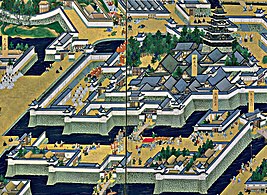 Edo Castle, 17th century
Edo Castle, 17th century
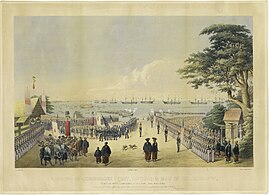 Commodore Matthew Perry expedition and his beginning arrival in Japan in 1853
Commodore Matthew Perry expedition and his beginning arrival in Japan in 1853
 celebrated Edo Places. Yamanote ( above ) Nihonbashi ( center ) and Shitamachi ( below ) ( circa 1858 )
celebrated Edo Places. Yamanote ( above ) Nihonbashi ( center ) and Shitamachi ( below ) ( circa 1858 )
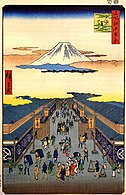 Suruga street with Mount Fuji by Hiroshige ( 1856 )
Suruga street with Mount Fuji by Hiroshige ( 1856 )
In 1869, the 17-year-old Emperor Meiji moved to Edo, and in accord, the city was renamed Tokyo ( meaning Eastern Capital ). The city was divided into Yamanote and Shitamachi. Tokyo was already the state ‘s political and cultural center, [ 23 ] and the emperor butterfly ‘s residence made it a de facto imperial capital equally well, with the former Edo Castle becoming the Imperial Palace. The city of Tokyo was officially established on May 1, 1889. The Tokyo Metro Ginza Line helping between Ueno and Asakusa was the first metro line built in Japan and East Asia completed on December 30, 1927. [ 12 ] Central Tokyo, like Osaka, has been designed since about 1900 to be centered on major railroad track stations in a high-density manner, so suburban railways were built relatively cheaply at street level and with their own right-of-way. Though expressways have been built in Tokyo, the basic design has not changed. [ citation needed ] Tokyo went on to suffer two major catastrophes in the twentieth century : the 1923 Great Kantō earthquake, which left 140,000 dead or missing ; and World War II. [ 24 ]
In 1943, the city of Tokyo merged with the prefecture of Tokyo to form the “ metropolitan prefecture ” of Tokyo. Since then, the Tokyo Metropolitan Government served as both the prefecture government for Tokyo, vitamin a well as administering the special wards of Tokyo, for what had previously been Tokyo City. World War II wreaked far-flung end of most of the city due to the dogged Allied atmosphere raids on Japan and the use of incendiary bomb bombs. The bombing of Tokyo in 1944 and 1945 is estimated to have killed between 75,000 and 200,000 civilians and left more than one-half of the city destroyed. [ 25 ] The deadliest night of the war came on March 9–10, 1945, the night of the american “ Operation Meetinghouse “ raid ; [ 26 ] as closely 700,000 arsonist bombs rained on the easterly half of the city, chiefly in heavily residential wards. Two-fifths of the city were wholly burned, more than 276,000 buildings were demolished, 100,000 civilians were killed, and 110,000 more were injured. [ 27 ] [ 28 ] Between 1940 and 1945, the population of Japan ‘s capital city dwindled from 6,700,000 to less than 2,800,000, with the majority of those who lost their homes living in “ bedraggled, makeshift huts ”. [ 29 ]
- Gallery
 Tokyo Bombing in 1945
Tokyo Bombing in 1945
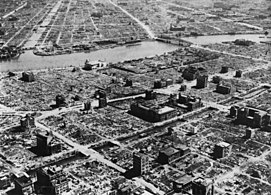 aftermath of Tokyo Bombing in March 1945
aftermath of Tokyo Bombing in March 1945
 Nihonbashi in 1946
Nihonbashi in 1946
After the war, Tokyo became the base from which the United States under Douglas MacArthur administered Japan for six years. Tokyo struggled to rebuild as occupation authorities stepped in and drastically cut back on japanese politics rebuilding programs, focusing rather on simply improving roads and transportation. Tokyo did not experience debauched economic increase until the 1950s. [ 30 ] After the occupation of Japan ended in 1952, Tokyo was wholly rebuild and was showcased to the world during the 1964 Summer Olympics. The 1970s and the 1980s brought new high-rise developments. In 1978, Sunshine 60 – the tallest skyscraper in Asia until 1985, and in Japan until 1991 [ 31 ] – and Narita International Airport were constructed, and the population increased to about 11 million in the metropolitan area. [ 32 ] The Edo-Tokyo Open Air Architectural Museum has historic japanese buildings that existed in the urban landscape of pre-war Tokyo. Tokyo ‘s underpass and commuter rail net became one of the busiest in the earth [ 33 ] as more and more people moved to the area. In the 1980s, real estate of the realm prices skyrocketed during a real estate and debt burp. The bubble burst in the early 1990s, and many companies, banks, and individuals were caught with mortgage-backed debts while veridical estate of the realm was shrinking in value. A major receding followed, making the 1990s Japan ‘s “ Lost Decade “, [ 34 ] from which it is now slowly recovering. Tokyo placid sees modern urban developments on large lots of less profitable land. recent projects include Ebisu Garden Place, Tennōzu Isle, Shiodome, Roppongi Hills, Shinagawa ( now besides a Shinkansen post ), and the Marunouchi side of Tokyo Station. Buildings of significance have been demolished for more up-to-date shop facilities such as Omotesando Hills. [ 35 ] Land reclamation projects in Tokyo have besides been going on for centuries. The most big is the Odaiba area, immediately a major shop and entertainment plaza. diverse plans have been proposed [ 36 ] for transferring national government functions from Tokyo to secondary capitals in early regions of Japan, to slow down rapid development in Tokyo and revitalize economically lagging areas of the state. These plans have been controversial [ 37 ] within Japan and have yet to be realized. The 2011 Tōhoku earthquake and tsunami that devastated much of the northeastern coast of Honshu was felt in Tokyo. however, ascribable to Tokyo ‘s earthquake-resistant infrastructure, damage in Tokyo was very minor compared to areas directly hit by the tsunami, [ 38 ] although action in the city was largely halted. [ 39 ] The subsequent nuclear crisis caused by the tsunami has besides largely leave Tokyo unaffected, despite periodic spikes in radiation levels. [ 40 ] [ 41 ] On September 7, 2013, the IOC selected Tokyo to host the 2020 Summer Olympics. Tokyo therefore became the foremost asian city to host the Olympic Games twice. [ 42 ] however, as a consequence of the COVID-19 pandemic, the 2020 Olympic Games were ultimately postponed to 2021. It is besides ill-defined how the city will deal with an increasing number of issues, urging scholars to offer potential alternatives approaches to tackle the most pressing problems. [ 43 ]
Geography and politics [edit ]
 Satellite photograph of Tokyo in 2018 taken by ESA Sentinel-2 The mainland part of Tokyo lies northwest of Tokyo Bay and measures about 90 km ( 56 nautical mile ) east to west and 25 kilometer ( 16 secret intelligence service ) north to south. The average elevation in Tokyo is 40 thousand ( 131 foot ). [ 44 ] Chiba Prefecture borders it to the east, Yamanashi to the west, Kanagawa to the south, and Saitama to the north. Mainland Tokyo is far subdivided into the especial wards ( occupying the eastern half ) and the Tama area ( 多摩地域 ) stretching westwards. Tokyo has a latitude of 35.65 ( near the 36th parallel north ), which makes it more southern than Rome ( 41.90 ), Madrid ( 40.41 ) and New York City ( 40.71 ). [ 45 ] besides within the administrative boundaries of Tokyo Metropolis are two island chains in the Pacific Ocean directly south : the Izu Islands, and the Ogasawara Islands, which stretch more than 1,000 kilometer ( 620 nautical mile ) away from the mainland. Because of these islands and the mountainous regions to the west, Tokyo ‘s overall population concentration figures far under-represent the real figures for the urban and suburban regions of Tokyo. [ 46 ] Under japanese jurisprudence, the prefecture of Tokyo is designated as a to ( 都 ), translated as metropolis. [ 47 ] Tokyo prefecture is the most populous prefecture and the densest, with 6,100 inhabitants per straight kilometer ( 16,000/sq secret intelligence service ) ; by geographic area it is the third-smallest, above lone Osaka and Kagawa. Its administrative structure is similar to that of Japan ‘s other prefectures. The 23 special wards ( 特別区, tokubetsu-ku ), which until 1943 constituted the city of Tokyo, are autonomous municipalities, each having a mayor, a council, and the status of a city. In addition to these 23 special wards, Tokyo besides includes 26 more cities ( 市 -shi ), five towns ( 町 -chō or machi ), and eight villages ( 村 -son or -mura ), each of which has a local government. The Tokyo Metropolitan Government administers the hale city including the 23 especial wards and the cities and towns that constitute the prefecture. It is headed by a publicly elected governor and metropolitan forum. Its headquarter is in Shinjuku Ward .
Satellite photograph of Tokyo in 2018 taken by ESA Sentinel-2 The mainland part of Tokyo lies northwest of Tokyo Bay and measures about 90 km ( 56 nautical mile ) east to west and 25 kilometer ( 16 secret intelligence service ) north to south. The average elevation in Tokyo is 40 thousand ( 131 foot ). [ 44 ] Chiba Prefecture borders it to the east, Yamanashi to the west, Kanagawa to the south, and Saitama to the north. Mainland Tokyo is far subdivided into the especial wards ( occupying the eastern half ) and the Tama area ( 多摩地域 ) stretching westwards. Tokyo has a latitude of 35.65 ( near the 36th parallel north ), which makes it more southern than Rome ( 41.90 ), Madrid ( 40.41 ) and New York City ( 40.71 ). [ 45 ] besides within the administrative boundaries of Tokyo Metropolis are two island chains in the Pacific Ocean directly south : the Izu Islands, and the Ogasawara Islands, which stretch more than 1,000 kilometer ( 620 nautical mile ) away from the mainland. Because of these islands and the mountainous regions to the west, Tokyo ‘s overall population concentration figures far under-represent the real figures for the urban and suburban regions of Tokyo. [ 46 ] Under japanese jurisprudence, the prefecture of Tokyo is designated as a to ( 都 ), translated as metropolis. [ 47 ] Tokyo prefecture is the most populous prefecture and the densest, with 6,100 inhabitants per straight kilometer ( 16,000/sq secret intelligence service ) ; by geographic area it is the third-smallest, above lone Osaka and Kagawa. Its administrative structure is similar to that of Japan ‘s other prefectures. The 23 special wards ( 特別区, tokubetsu-ku ), which until 1943 constituted the city of Tokyo, are autonomous municipalities, each having a mayor, a council, and the status of a city. In addition to these 23 special wards, Tokyo besides includes 26 more cities ( 市 -shi ), five towns ( 町 -chō or machi ), and eight villages ( 村 -son or -mura ), each of which has a local government. The Tokyo Metropolitan Government administers the hale city including the 23 especial wards and the cities and towns that constitute the prefecture. It is headed by a publicly elected governor and metropolitan forum. Its headquarter is in Shinjuku Ward .

Municipalities [edit ]
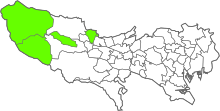 Map of Nishi-Tama District in green
Map of Nishi-Tama District in green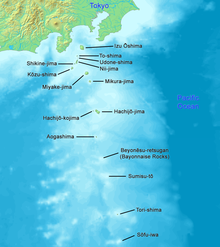 Map of the Izu Islands in black labels
Map of the Izu Islands in black labels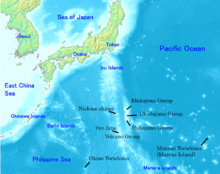 Map of the Ogasawara Islands in black labels Since 2001, Tokyo consists of 62 municipalities : 23 special wards, 26 cities, 5 towns and 8 villages. Any municipality of Japan has a immediately elected mayor and a directly elected assembly, each elected on mugwump four-year cycles. 23 of Tokyo ‘s municipalities cover the area that had been Tokyo City until WWII, 30 remain today in the Tama sphere ( early North Tama, West Tama and South Tama districts ), 9 on Tokyo ‘s outlying islands .
Map of the Ogasawara Islands in black labels Since 2001, Tokyo consists of 62 municipalities : 23 special wards, 26 cities, 5 towns and 8 villages. Any municipality of Japan has a immediately elected mayor and a directly elected assembly, each elected on mugwump four-year cycles. 23 of Tokyo ‘s municipalities cover the area that had been Tokyo City until WWII, 30 remain today in the Tama sphere ( early North Tama, West Tama and South Tama districts ), 9 on Tokyo ‘s outlying islands .
 Tama
Tama
Hachioji
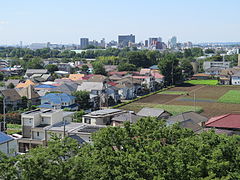 Musashino
Musashino
municipal mergers [edit ]
When Tokyo reached its current extent except for smaller border changes in 1893, it consisted of over 170 municipalities, 1 ( by definition : district-independent ) city, nine districts with their towns and villages, plus the island communities that had never separate of ritsuryō [ clarification needed ] districts. By 1953, the number of municipalities had dropped to 97. The stream total of 62 was reached in 2001 .
National parks [edit ]
 Ogasawara National Park, a UNESCO World Natural Heritage web site As of March 31, 2008, 36 % of the total land area of the prefecture was designated as Natural Parks ( second only to Shiga Prefecture ), namely the Chichibu Tama Kai, Fuji-Hakone-Izu, and Ogasawara National Parks ( the last a UNESCO World Heritage Site ) ; Meiji no Mori Takao Quasi-National Park ; and Akikawa Kyūryō, Hamura Kusabana Kyūryō, Sayama, Takao Jinba, Takiyama, and Tama Kyūryō Prefectural Natural Parks. [ 55 ] A number of museums are located in Ueno Park : Tokyo National Museum, National Museum of Nature and Science, Shitamachi Museum and National Museum for western Art, among others. There are besides artworks and statues at several places in the ballpark. There is besides a menagerie in the park, and the ballpark is a popular address to view cherry blossoms .
Ogasawara National Park, a UNESCO World Natural Heritage web site As of March 31, 2008, 36 % of the total land area of the prefecture was designated as Natural Parks ( second only to Shiga Prefecture ), namely the Chichibu Tama Kai, Fuji-Hakone-Izu, and Ogasawara National Parks ( the last a UNESCO World Heritage Site ) ; Meiji no Mori Takao Quasi-National Park ; and Akikawa Kyūryō, Hamura Kusabana Kyūryō, Sayama, Takao Jinba, Takiyama, and Tama Kyūryō Prefectural Natural Parks. [ 55 ] A number of museums are located in Ueno Park : Tokyo National Museum, National Museum of Nature and Science, Shitamachi Museum and National Museum for western Art, among others. There are besides artworks and statues at several places in the ballpark. There is besides a menagerie in the park, and the ballpark is a popular address to view cherry blossoms .
Earthquakes [edit ]
Minor quakes [edit ]
 A bilingual sign with instructions ( in Japanese and English ) in case of an earthquake ( Shibuya ) Tokyo is near the limit of three plates, making it an extremely active area for smaller quakes and slippage which frequently affect the urban sphere with swing as if in a gravy boat, although epicenters within mainland Tokyo ( excluding Tokyo ‘s 2,000 kilometer ( 1,243 mile ) –long island legal power ) are quite rare. It is not rare in the metro area to have hundreds of these minor quakes ( magnitudes 4–6 ) that can be felt in a one year, something local residents merely brush off but can be a informant of anxiety not only for alien visitors but for japanese from elsewhere arsenic well. They rarely cause much damage ( sometimes a few injuries ) as they are either excessively small or far away as quakes tend to dance around the region. peculiarly active agent are offshore regions and to a lesser extent Chiba and Ibaraki. [ 56 ]
A bilingual sign with instructions ( in Japanese and English ) in case of an earthquake ( Shibuya ) Tokyo is near the limit of three plates, making it an extremely active area for smaller quakes and slippage which frequently affect the urban sphere with swing as if in a gravy boat, although epicenters within mainland Tokyo ( excluding Tokyo ‘s 2,000 kilometer ( 1,243 mile ) –long island legal power ) are quite rare. It is not rare in the metro area to have hundreds of these minor quakes ( magnitudes 4–6 ) that can be felt in a one year, something local residents merely brush off but can be a informant of anxiety not only for alien visitors but for japanese from elsewhere arsenic well. They rarely cause much damage ( sometimes a few injuries ) as they are either excessively small or far away as quakes tend to dance around the region. peculiarly active agent are offshore regions and to a lesser extent Chiba and Ibaraki. [ 56 ]
Infrequent knock-down quakes [edit ]
Tokyo has been hit by powerful megathrust earthquakes in 1703, 1782, 1812, 1855, 1923, and much more indirectly ( with some liquefaction in landfill zones ) in 2011 ; [ 57 ] [ 58 ] the frequency of directly and large quakes is a proportional curio. The 1923 earthquake, with an calculate magnitude of 8.3, killed 142,000 people, the last meter the urban area was immediately hit. The 2011 tremor concentrate was hundreds of kilometers away and resulted in no direct deaths in the metropolitan sphere .
volcanic eruptions [edit ]
Mount Fuji is about 100 km ( 62 security service ) southwest of Tokyo. There is a low risk of outbreak. The end recorded was the Hōei eruption which started on December 16, 1707, and ended approximately January 1, 1708 ( 16 days ). [ 59 ] During the Hōei eruption, the ash measure was 4 centimeter in southerly Tokyo ( true laurel area ) and 2 curium to 0.5 centimeter in cardinal Tokyo. [ 60 ] Kanagawa had 16 curium to 8 centimeter ash and Saitama 0.5 to 0 centimeter. [ 60 ] If the wind blows northeast it could send volcanic ash to Tokyo city. [ 61 ] According to the government, less than a millimeter of the volcanic ash from a Mt. Fuji eruption could cause office power system problems such as blackouts and stop trains in the Tokyo metropolitan area. [ 61 ] A mixture of ash with rain could stick to cellphone antenna, power lines and cause irregular power outages. [ 61 ] The affect areas would need to be evacuated. [ 61 ]
Water management [edit ]
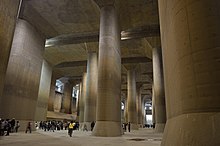 The MAOUDC is the global ‘s largest underground diversion floodwater facility Tokyo is located on the Kantō Plain with 5 river systems and dozens of rivers that expand during each season. [ 62 ] Important rivers are Edogawa, Nakagawa, Arakawa, Kandagawa, Megurogawa and Tamagawa. [ 63 ] In 1947 Typhoon Kathleen struck Tokyo, destroying 31,000 homes and killing 1,100 people. [ 62 ] In 1958 Typhoon Ida inflicted 400 millimeter rain in 1 workweek which flooded streets. [ 62 ] In the 1950s and 1960s, the government invested 6–7 % of the national budget on disaster and risk reduction. [ 62 ] A huge system of dams, levees and tunnels was constructed. [ 62 ] The purpose is to manage heavy rain, typhonic rain, and river floods. [ 62 ] Tokyo has presently the universe ‘s largest clandestine floodwater diversion facility called the Metropolitan Area Outer Underground Discharge Channel ( MAOUDC ). [ 11 ] [ 62 ] It took 13 years to build and was completed in 2006. The MAOUDC is a 6.3 kilometer long system of tunnels, 22 meters underground, with 70 meter tall cylindrical tanks, where each tank is large enough to fit a space shuttle or the Statue of Liberty. [ 62 ] During floods, surfeit body of water is collected from rivers and drained to the Edo River. [ 63 ] low-lying areas of Kōtō, Edogawa, Sumida, Katsushika, Taitō and Arakawa near the Arakawa River are most at risk of flooding. [ 63 ]
The MAOUDC is the global ‘s largest underground diversion floodwater facility Tokyo is located on the Kantō Plain with 5 river systems and dozens of rivers that expand during each season. [ 62 ] Important rivers are Edogawa, Nakagawa, Arakawa, Kandagawa, Megurogawa and Tamagawa. [ 63 ] In 1947 Typhoon Kathleen struck Tokyo, destroying 31,000 homes and killing 1,100 people. [ 62 ] In 1958 Typhoon Ida inflicted 400 millimeter rain in 1 workweek which flooded streets. [ 62 ] In the 1950s and 1960s, the government invested 6–7 % of the national budget on disaster and risk reduction. [ 62 ] A huge system of dams, levees and tunnels was constructed. [ 62 ] The purpose is to manage heavy rain, typhonic rain, and river floods. [ 62 ] Tokyo has presently the universe ‘s largest clandestine floodwater diversion facility called the Metropolitan Area Outer Underground Discharge Channel ( MAOUDC ). [ 11 ] [ 62 ] It took 13 years to build and was completed in 2006. The MAOUDC is a 6.3 kilometer long system of tunnels, 22 meters underground, with 70 meter tall cylindrical tanks, where each tank is large enough to fit a space shuttle or the Statue of Liberty. [ 62 ] During floods, surfeit body of water is collected from rivers and drained to the Edo River. [ 63 ] low-lying areas of Kōtō, Edogawa, Sumida, Katsushika, Taitō and Arakawa near the Arakawa River are most at risk of flooding. [ 63 ]
climate [edit ]
The former city of Tokyo and the majority of Tokyo prefecture lie in the humid subtropical climate zone ( Köppen climate categorization Cfa ), [ 64 ] with hot, humid summers and meek to cool winters with episodic cold spells. The region, like much of Japan, experiences a one-month seasonal lag, with the warmest calendar month being August, which averages 26.4 °C ( 79.5 °F ), and the coolest month being January, averaging 5.2 °C ( 41.4 °F ). The read low temperature is −9.2 °C ( 15.4 °F ) on January 13, 1876, while the record high is 39.5 °C ( 103.1 °F ) on July 20, 2004. The phonograph record highest humble temperature is 30.3 °C ( 86.5 °F ) on August 12, 2013, making Tokyo one of alone seven observation sites in Japan that have recorded a low temperature over 30 °C ( 86.0 °F ). [ 65 ] Annual rain averages about 1,530 millimeters ( 60.2 in ), with a wetter summer and a dry winter. The growing temper in Tokyo lasts for about 322 days from around mid February to early January. [ 66 ] Snowfall is sporadic, but does occur about per annum. [ 67 ] Tokyo besides much sees typhoons every year, though few are hard. The wettest calendar month since records began in 1876 was October 2004, with 780 millimeters ( 30 in ) of rain, [ 68 ] including 270.5 millimeter ( 10.65 in ) on the ninth of that calendar month ; [ 69 ] the last of four months on record to observe no precipitation is December 1995. [ 65 ] Annual haste has ranged from 879.5 millimeter ( 34.63 in ) in 1984 to 2,229.6 millimeter ( 87.78 in ) in 1938. [ 65 ]
| Climate data for Kitanomaru Park, Chiyoda ward, Tokyo, 1991–2020 normals, extremes 1875–present[70] | |||||||||||||
|---|---|---|---|---|---|---|---|---|---|---|---|---|---|
| Month | Jan | Feb | Mar | Apr | May | Jun | Jul | Aug | Sep | Oct | Nov | Dec | Year |
| Record high °C (°F) | 22.6 (72.7) |
24.9 (76.8) |
25.3 (77.5) |
29.2 (84.6) |
32.6 (90.7) |
36.2 (97.2) |
39.5 (103.1) |
39.1 (102.4) |
38.1 (100.6) |
32.6 (90.7) |
27.3 (81.1) |
24.8 (76.6) |
39.5 (103.1) |
| Average high °C (°F) | 9.8 (49.6) |
10.9 (51.6) |
14.2 (57.6) |
19.4 (66.9) |
23.6 (74.5) |
26.1 (79.0) |
29.9 (85.8) |
31.3 (88.3) |
27.5 (81.5) |
22.0 (71.6) |
16.7 (62.1) |
12.0 (53.6) |
20.3 (68.5) |
| Daily mean °C (°F) | 5.4 (41.7) |
6.1 (43.0) |
9.4 (48.9) |
14.3 (57.7) |
18.8 (65.8) |
21.9 (71.4) |
25.7 (78.3) |
26.9 (80.4) |
23.3 (73.9) |
18.0 (64.4) |
12.5 (54.5) |
7.7 (45.9) |
15.8 (60.4) |
| Average low °C (°F) | 1.2 (34.2) |
2.1 (35.8) |
5.0 (41.0) |
9.8 (49.6) |
14.6 (58.3) |
18.5 (65.3) |
22.4 (72.3) |
23.5 (74.3) |
20.3 (68.5) |
14.8 (58.6) |
8.8 (47.8) |
3.8 (38.8) |
12.1 (53.8) |
| Record low °C (°F) | −9.2 (15.4) |
−7.9 (17.8) |
−5.6 (21.9) |
−3.1 (26.4) |
2.2 (36.0) |
8.5 (47.3) |
13.0 (55.4) |
15.4 (59.7) |
10.5 (50.9) |
−0.5 (31.1) |
−3.1 (26.4) |
−6.8 (19.8) |
−9.2 (15.4) |
| Average precipitation mm (inches) | 59.7 (2.35) |
56.5 (2.22) |
116.0 (4.57) |
133.7 (5.26) |
139.7 (5.50) |
167.8 (6.61) |
156.2 (6.15) |
154.7 (6.09) |
224.9 (8.85) |
234.8 (9.24) |
96.3 (3.79) |
57.9 (2.28) |
1,598.2 (62.92) |
| Average snowfall cm (inches) | 4 (1.6) |
4 (1.6) |
0 (0) |
0 (0) |
0 (0) |
0 (0) |
0 (0) |
0 (0) |
0 (0) |
0 (0) |
0 (0) |
0 (0) |
8 (3.1) |
| Average precipitation days ( ≥ 0.5 millimeter ) | 5.3 | 6.1 | 10.3 | 10.9 | 11.1 | 12.8 | 12.0 | 9.4 | 12.3 | 11.8 | 8.2 | 5.8 | 116.0 |
| Average relative humidity (%) | 51 | 52 | 57 | 62 | 68 | 75 | 76 | 74 | 75 | 71 | 64 | 56 | 65 |
| Mean monthly sunshine hours | 192.6 | 170.4 | 175.3 | 178.8 | 179.6 | 124.2 | 151.4 | 174.2 | 126.7 | 129.4 | 149.8 | 174.4 | 1,926.7 |
| Average ultraviolet index | 2 | 3 | 5 | 7 | 9 | 10 | 10 | 10 | 8 | 5 | 3 | 2 | 6 |
| Source: Japan Meteorological Agency[71][72][65] and Weather Atlas[73] | |||||||||||||
Tokyo has experienced significant heating of its climate since temperature records began in 1876 .
| Climate data for Tokyo (Tokyo, Japan), 1876–1905 normals | |||||||||||||
|---|---|---|---|---|---|---|---|---|---|---|---|---|---|
| Month | Jan | Feb | Mar | Apr | May | Jun | Jul | Aug | Sep | Oct | Nov | Dec | Year |
| Average high °C (°F) | 8.3 (46.9) |
8.7 (47.7) |
11.9 (53.4) |
17.2 (63.0) |
21.1 (70.0) |
24.5 (76.1) |
28.1 (82.6) |
29.8 (85.6) |
26.1 (79.0) |
20.5 (68.9) |
15.5 (59.9) |
11.0 (51.8) |
18.6 (65.5) |
| Daily mean °C (°F) | 2.9 (37.2) |
3.6 (38.5) |
6.9 (44.4) |
12.4 (54.3) |
16.6 (61.9) |
20.5 (68.9) |
24.1 (75.4) |
25.5 (77.9) |
22.1 (71.8) |
15.9 (60.6) |
10.2 (50.4) |
5.3 (41.5) |
13.8 (56.8) |
| Average low °C (°F) | −1.7 (28.9) |
−0.9 (30.4) |
2.0 (35.6) |
7.6 (45.7) |
12.0 (53.6) |
16.8 (62.2) |
20.8 (69.4) |
21.9 (71.4) |
18.6 (65.5) |
11.9 (53.4) |
5.4 (41.7) |
0.4 (32.7) |
9.6 (49.3) |
| Average precipitation mm (inches) | 55.2 (2.17) |
72.4 (2.85) |
111.0 (4.37) |
129.1 (5.08) |
151.9 (5.98) |
166.3 (6.55) |
139.7 (5.50) |
114.7 (4.52) |
203.3 (8.00) |
184.1 (7.25) |
104.7 (4.12) |
58.7 (2.31) |
1,491.1 (58.7) |
| Mean monthly sunshine hours | 186.7 | 178.5 | 174.1 | 183.1 | 204.8 | 158.5 | 183.9 | 207.0 | 142.8 | 144.0 | 167.4 | 190.8 | 2,121.6 |
| Source: Japan Meteorological Agency[74] | |||||||||||||
The western mountainous area of mainland Tokyo, Okutama besides lies in the humid subtropical climate ( Köppen classification Cfa ) .
| Climate data for Ogouchi, Okutama town, Tokyo, 1991–2020 normals, extremes 1875–present | |||||||||||||
|---|---|---|---|---|---|---|---|---|---|---|---|---|---|
| Month | Jan | Feb | Mar | Apr | May | Jun | Jul | Aug | Sep | Oct | Nov | Dec | Year |
| Record high °C (°F) | 17.8 (64.0) |
20.9 (69.6) |
22.9 (73.2) |
30.6 (87.1) |
33.0 (91.4) |
34.3 (93.7) |
36.3 (97.3) |
36.4 (97.5) |
35.0 (95.0) |
30.2 (86.4) |
23.8 (74.8) |
22.8 (73.0) |
36.4 (97.5) |
| Average high °C (°F) | 6.8 (44.2) |
7.6 (45.7) |
10.9 (51.6) |
16.5 (61.7) |
21.1 (70.0) |
23.4 (74.1) |
27.4 (81.3) |
28.5 (83.3) |
24.3 (75.7) |
18.8 (65.8) |
14.0 (57.2) |
9.3 (48.7) |
17.4 (63.3) |
| Daily mean °C (°F) | 1.5 (34.7) |
2.2 (36.0) |
5.5 (41.9) |
10.8 (51.4) |
15.6 (60.1) |
18.9 (66.0) |
22.6 (72.7) |
23.5 (74.3) |
19.8 (67.6) |
14.3 (57.7) |
8.8 (47.8) |
3.9 (39.0) |
12.3 (54.1) |
| Average low °C (°F) | −2.4 (27.7) |
−1.9 (28.6) |
1.0 (33.8) |
5.8 (42.4) |
10.9 (51.6) |
15.3 (59.5) |
19.3 (66.7) |
20.1 (68.2) |
16.6 (61.9) |
10.9 (51.6) |
5.0 (41.0) |
0.1 (32.2) |
8.4 (47.1) |
| Record low °C (°F) | −9.3 (15.3) |
−11.6 (11.1) |
−8.1 (17.4) |
−3.8 (25.2) |
0.7 (33.3) |
7.5 (45.5) |
12.4 (54.3) |
13.2 (55.8) |
6.2 (43.2) |
1.0 (33.8) |
−2.1 (28.2) |
−6.9 (19.6) |
−11.6 (11.1) |
| Average precipitation mm (inches) | 49.5 (1.95) |
45.9 (1.81) |
88.5 (3.48) |
106.3 (4.19) |
118.7 (4.67) |
163.2 (6.43) |
205.6 (8.09) |
217.4 (8.56) |
270.2 (10.64) |
215.4 (8.48) |
68.9 (2.71) |
43.7 (1.72) |
1,608 (63.31) |
| Mean monthly sunshine hours | 206.5 | 187.7 | 173.0 | 178.4 | 172.2 | 104.2 | 124.8 | 144.6 | 104.5 | 128.7 | 164.5 | 186.5 | 1,874.6 |
| Source: Japan Meteorological Agency[75][76] | |||||||||||||
The climates of Tokyo ‘s offshore territories vary significantly from those of the city. The climate of Chichijima in Ogasawara greenwich village is on the limit between the tropical savanna climate ( Köppen classification Aw ) and the tropical rain forest climate ( Köppen classification Af ). It is approximately 1,000 km ( 621 mile ) south of the Greater Tokyo Area resulting in much different climatic conditions .
| Climate data for Chichijima, Ogasawara, Tokyo, 1991–2020 normals, extremes 1896–present | |||||||||||||
|---|---|---|---|---|---|---|---|---|---|---|---|---|---|
| Month | Jan | Feb | Mar | Apr | May | Jun | Jul | Aug | Sep | Oct | Nov | Dec | Year |
| Record high °C (°F) | 26.1 (79.0) |
25.4 (77.7) |
26.7 (80.1) |
28.4 (83.1) |
30.1 (86.2) |
33.0 (91.4) |
34.1 (93.4) |
33.7 (92.7) |
33.1 (91.6) |
32.1 (89.8) |
30.2 (86.4) |
27.5 (81.5) |
34.1 (93.4) |
| Average high °C (°F) | 20.7 (69.3) |
20.5 (68.9) |
21.7 (71.1) |
23.4 (74.1) |
25.6 (78.1) |
28.5 (83.3) |
30.4 (86.7) |
30.3 (86.5) |
29.9 (85.8) |
28.6 (83.5) |
25.9 (78.6) |
22.7 (72.9) |
25.7 (78.3) |
| Daily mean °C (°F) | 18.5 (65.3) |
18.1 (64.6) |
19.3 (66.7) |
21.1 (70.0) |
23.4 (74.1) |
26.2 (79.2) |
27.7 (81.9) |
28.0 (82.4) |
27.7 (81.9) |
26.4 (79.5) |
23.8 (74.8) |
20.6 (69.1) |
23.4 (74.1) |
| Average low °C (°F) | 15.8 (60.4) |
15.4 (59.7) |
16.8 (62.2) |
18.8 (65.8) |
21.4 (70.5) |
24.4 (75.9) |
25.6 (78.1) |
26.1 (79.0) |
25.7 (78.3) |
24.4 (75.9) |
21.6 (70.9) |
18.2 (64.8) |
21.2 (70.2) |
| Record low °C (°F) | 8.9 (48.0) |
7.8 (46.0) |
9.2 (48.6) |
10.7 (51.3) |
13.9 (57.0) |
17.7 (63.9) |
20.8 (69.4) |
22.2 (72.0) |
19.6 (67.3) |
17.2 (63.0) |
13.2 (55.8) |
10.8 (51.4) |
7.8 (46.0) |
| Average rainfall mm (inches) | 63.6 (2.50) |
51.6 (2.03) |
75.8 (2.98) |
113.3 (4.46) |
151.9 (5.98) |
111.8 (4.40) |
79.5 (3.13) |
123.3 (4.85) |
144.2 (5.68) |
141.7 (5.58) |
136.1 (5.36) |
103.3 (4.07) |
1,296.1 (51.02) |
| Average rainy days ( ≥ 0.5 millimeter ) | 11.0 | 8.5 | 9.8 | 10.0 | 11.8 | 8.8 | 8.6 | 11.3 | 13.4 | 13.7 | 12.0 | 11.2 | 130.1 |
| Average relative humidity (%) | 66 | 68 | 72 | 79 | 84 | 86 | 82 | 82 | 82 | 81 | 76 | 70 | 77 |
| Mean monthly sunshine hours | 131.3 | 138.3 | 159.2 | 148.3 | 151.8 | 205.6 | 246.8 | 213.7 | 197.7 | 173.2 | 139.1 | 125.3 | 2,030.3 |
| Source: Japan Meteorological Agency[77] [ 78 ] |
|||||||||||||
Tokyo ‘s easternmost territory, the island of Minamitorishima in Ogasawara village, is in the tropical savanna climate zone ( Köppen categorization Aw ). Tokyo ‘s Izu and Ogasawara islands are affected by an average of 5.4 typhoons a year, compared to 3.1 in mainland Kantō. [ 79 ]
cityscape [edit ]
architecture in Tokyo has largely been shaped by Tokyo ‘s history. Twice in late history has the city been left in ruins : beginning in the 1923 Great Kantō earthquake and later after extensive firebomb in World War II. [ 80 ] Because of this, Tokyo ‘s urban landscape consists chiefly of modern and contemporary architecture, and older buildings are barely. [ 80 ] Tokyo features many internationally celebrated forms of advanced computer architecture including Tokyo International Forum, Asahi Beer Hall, Mode Gakuen Cocoon Tower, NTT Docomo Yoyogi Building and Rainbow Bridge. Tokyo besides features two classifiable towers : Tokyo Tower, and the fresh Tokyo Skytree, which is the tallest column in both Japan and the universe, and the second tall structure in the world after the Burj Khalifa in Dubai. [ 10 ] Mori Building Co started workplace on Tokyo ‘s new improbable build which is set to be finished in March 2023. The project will cost 580 billion yen ( $ 5.5 billion ). [ 81 ] Tokyo besides contains numerous parks and gardens. There are four home parks in Tokyo Prefecture, including the Fuji-Hakone-Izu National Park, which includes all of the Izu Islands.
environment [edit ]
Tokyo has enacted a measure to cut greenhouse gases. Governor Shintaro Ishihara created Japan ‘s first base emissions detonator system, aiming to reduce greenhouse gas discharge by a entire of 25 % by 2020 from the 2000 level. [ 82 ] Tokyo is an example of an urban heating system island, and the phenomenon is particularly serious in its special wards. [ 83 ] [ 84 ] According to the Tokyo Metropolitan Government, [ 85 ] the annual think of temperature has increased by about 3 °C ( 5.4 °F ) over the by 100 years. Tokyo has been cited as a “ convert case of the relationship between urban growth and climate ”. [ 86 ] In 2006, Tokyo enacted the “ 10 year project for k Tokyo ” to be realized by 2016. It set a goal of increasing wayside trees in Tokyo to 1 million ( from 480,000 ), and adding 1,000 hour angle of green space 88 of which will be a new park named “ Umi no Mori ” ( Sea Forest ) which will be on a reclaim island in Tokyo Bay which used to be a landfill. [ 87 ] From 2007 to 2010, 436 hour angle of the planned 1,000 hour angle of fleeceable space was created and 220,000 trees were planted bringing the sum to 700,000. In 2014, road side trees in Tokyo have increased to 950,000, and a far 300 hour angle of green space has been added. [ 88 ]
Demographics [edit ]
| Year | Pop. | ±% |
|---|---|---|
| 1870 | 590,268 | — |
| 1880 | 712,259 | +20.7% |
| 1890 | 1,389,684 | +95.1% |
| 1900 | 1,580,124 | +13.7% |
| 1910 | 2,202,079 | +39.4% |
| 1920 | 3,699,428 | +68.0% |
| 1925 | 4,485,144 | +21.2% |
| 1930 | 5,408,678 | +20.6% |
| 1935 | 6,369,919 | +17.8% |
| 1940 | 7,354,971 | +15.5% |
| 1945 | 3,488,284 | −52.6% |
| 1950 | 6,277,500 | +80.0% |
| 1955 | 8,037,084 | +28.0% |
| 1960 | 9,683,802 | +20.5% |
| 1965 | 10,869,244 | +12.2% |
| 1970 | 11,408,071 | +5.0% |
| 1975 | 11,673,554 | +2.3% |
| 1980 | 11,618,281 | −0.5% |
| 1985 | 11,829,363 | +1.8% |
| 1990 | 11,855,563 | +0.2% |
| 1995 | 11,773,605 | −0.7% |
| 2000 | 12,064,101 | +2.5% |
| 2005 | 12,576,601 | +4.2% |
| 2010 | 13,159,388 | +4.6% |
| 2015 | 13,515,271 | +2.7% |
| 2020 | 13,982,112 | +3.5% |
As of October 2012, the official intercensal estimate showed 13.506 million people in Tokyo with 9.214 million live within Tokyo ‘s 23 wards. [ 89 ] During the day, the population swells by over 2.5 million as workers and students commute from adjacent areas. This consequence is even more pronounce in the three cardinal wards of Chiyoda, Chūō, and Minato, whose corporate population as of the 2005 National Census was 326,000 at night, but 2.4 million during the day. [ 90 ] In 1889, the Home Ministry recorded 1,375,937 people in Tokyo City and a full of 1,694,292 people in Tokyo-fu. [ 91 ] In the lapp class, a total of 779 foreign nationals were recorded as reside in Tokyo. The most common nationality was English ( 209 residents ), followed by American ( 182 ) and chinese nationals ( 137 ). [ 92 ]
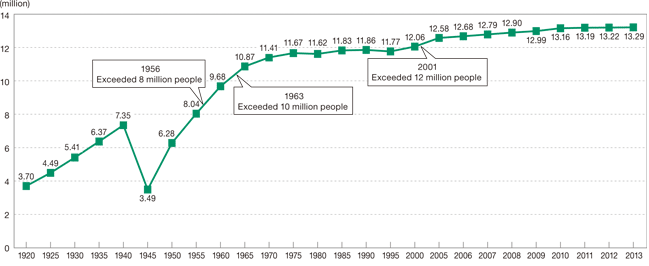 Tokyo historical population since 1920 Tokyo historical population since 1920 |
|
||||||||||||||||||||||||||
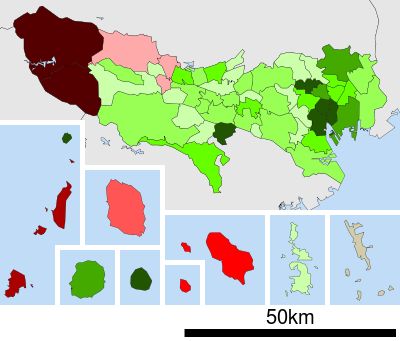 Increase Increase
10.0 % and over
7.5–9.9 %
5.0–7.4 %
2.5–4.9 %
0.0–2.4 % Decrease
0.0–2.4 %
2.5–4.9 %
5.0–7.4 %
7.5–9.9 %
10.0 % and over This chart is increase rate of municipalities of Tokyo, Japan. It is estimated by census carried out in 2005 and 2010 . |
|
||||||||||||||||||||||||||
economy [edit ]
 Ginza is a popular upscale shopping area in Tokyo.
Ginza is a popular upscale shopping area in Tokyo.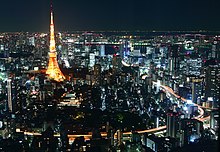
transportation [edit ]
Tokyo, which is the center of the Greater Tokyo Area, is Japan ‘s largest domestic and international hub for rail and ground transportation. however, its airspace has been under the US military ‘s single control after World War II. Public fare within Tokyo is dominated by an across-the-board net of “ clean and efficient ” [ 103 ] trains and subways run by a variety show of operators, with buses, monorails and trams playing a secondary eater function. There are up to 62 electric discipline lines and more than 900 train stations in Tokyo. [ 104 ] Shibuya Crossing is the “ global ‘s busiest pedestrian ford ”, with around 3,000 people crossing at a time. [ 105 ] [ 106 ] [ 107 ] As a leave of World War II, japanese planes are by and large forbidden to fly over Tokyo. [ 108 ] Therefore, Japan constructed airports outside Tokyo. Narita International Airport in Chiba Prefecture is the major gateway for external travelers to Japan. Japan ‘s sag carrier wave Japan Airlines, arsenic well as All Nippon Airways, have a hub at this airport. Haneda Airport on the reclaim land at Ōta, offers domestic and external flights. As of 2018, some flight routes into Haneda are permitted through Tokyo airspace. [ 109 ] assorted islands governed by Tokyo have their own airports. Hachijō-jima ( Hachijojima Airport ), Miyakejima ( Miyakejima Airport ), and Izu Ōshima ( Oshima Airport ) have services to Tokyo International and other airports. Rail is the chief manner of exile in Tokyo, [ citation needed ] which has the most extensive urban railway network in the worldly concern and an equally across-the-board network of open lines. JR East operates Tokyo ‘s largest railroad track network, including the Yamanote Line loop that circles the focus on of downtown Tokyo. It operates rail lines in the integral metropolitan area of Tokyo and in the lie of the northeastern depart of Honshu. JR East is besides responsible for Shinkansen high-speed rail lines. Two different organizations operate the underpass network : the private Tokyo Metro and the governmental Tokyo Metropolitan Bureau of Transportation. The metropolitan Government and individual carriers operate bus routes and one tram road. Local, regional, and national services are available, with major terminals at the colossus railroad stations, including Tokyo, Shinagawa, and Shinjuku. Expressways link the capital to early points in the Greater Tokyo Area, the Kantō area, and the islands of Kyushu and Shikoku. To build them cursorily before the 1964 Summer Olympics, most were constructed above existing roads. [ 110 ] early exile includes cab operate in the special wards and the cities and towns. besides, long-distance ferries serve the islands of Tokyo and carry passengers and cargo to domestic and alien ports .
education [edit ]
Tokyo has many universities, junior colleges, and vocational schools. Many of Japan ‘s most prestigious universities are in Tokyo, including University of Tokyo, Hitotsubashi University, Meiji University, Tokyo Institute of Technology, Waseda University, Tokyo University of Science, Sophia University, and Keio University. [ 111 ] Some of the biggest national universities in Tokyo are :
There is only one non-national populace university : Tokyo Metropolitan University. There are besides a few universities well known for classes conducted in English and for the teach of the japanese language, including the Globis University Graduate School of Management, International Christian University, Sophia University, and Waseda University Tokyo is besides the headquarters of the United Nations University. Publicly run kindergartens, elementary schools ( years 1 through 6 ), and primary schools ( 7 through 9 ) are operated by local wards or municipal offices. Public secondary schools in Tokyo are run by the Tokyo Metropolitan Government Board of Education and are called “ Metropolitan High Schools ”. Tokyo besides has many private schools from kindergarten through high school :
culture [edit ]
Tokyo has many museums. In Ueno Park, there is the Tokyo National Museum, the country ‘s largest museum and specializing in traditional japanese art ; the National Museum of western Art and Ueno Zoo. other museums include the National Museum of Emerging Science and Innovation in Odaiba ; the Edo-Tokyo Museum in Sumida, across the Sumida River from the center of Tokyo ; the Nezu Museum in Aoyama ; and the National Diet Library, National Archives, and the National Museum of Modern Art, which are near the Imperial Palace. Tokyo has many theaters for performing arts. These include national and individual theaters for traditional forms of japanese drama. Noteworthy are the National Noh Theatre for noh and the Kabuki-za for Kabuki. [ 112 ] Symphony orchestras and other musical organizations perform modern and traditional music. The New National Theater Tokyo in Shibuya is the national center for the perform arts, including opera, ballet, contemporary dance and play. [ 113 ] Tokyo besides hosts advanced japanese and international popular, and rock music at venues ranging in size from inner clubs to internationally known areas such as the Nippon Budokan .
many different festivals occur throughout Tokyo. major events include the Sannō at Hie Shrine, the Sanja at Asakusa Shrine, and the biennial Kanda Festivals. The survive features a parade with elaborately decorated floats and thousands of people. per annum on the last Saturday of July, an enormous fireworks display over the Sumida River attracts over a million viewers. once cherry blossoms bloom in spring, many residents gather in Ueno Park, Inokashira Park, and the Shinjuku Gyoen National Garden for picnics under the blossoms. Harajuku, a region in Shibuya, is known internationally for its youth dash, fashion [ 114 ] and cosplay. cuisine in Tokyo is internationally acclaimed. In November 2007, Michelin released their first gear steer for very well dining in Tokyo, awarding 191 stars in total, or about twice equally many as Tokyo ‘s nearest rival, Paris. As of 2017, 227 restaurants in Tokyo have been awarded ( 92 in Paris ). Twelve establishments were awarded the maximal of three stars ( Paris has 10 ), 54 received two stars, and 161 earned one ace. [ 115 ]
Sports [edit ]
Tokyo, with a diverse array of sports, is home to two professional baseball clubs, the Yomiuri Giants who play at the Tokyo Dome and Tokyo Yakult Swallows at Meiji-Jingu Stadium. The Japan Sumo Association is besides headquartered in Tokyo at the Ryōgoku Kokugikan sumo arena where three official sumo tournaments are held annually ( in January, May, and September ). football clubs in Tokyo include F.C. Tokyo and Tokyo Verdy 1969, both of which play at Ajinomoto Stadium in Chōfu, and FC Machida Zelvia at Nozuta Stadium in Machida. Basketball clubs include the Hitachi SunRockers, Toyota Alvark Tokyo and Tokyo Excellence. Tokyo hosted the 1964 Summer Olympics, therefore becoming the beginning asian city to host the Summer Games. The National Stadium, besides known as the Olympic Stadium, was host to a numeral of external sporting events. In 2016, it was to be replaced by the New National Stadium. With a number of first sports venues, Tokyo much hosts national and external sporting events such as basketball tournaments, women ‘s volleyball tournaments, tennis tournaments, swimming meets, marathons, rugby union and sevens rugby games, football, American football exhibition games, judo, and karate. Tokyo Metropolitan Gymnasium, in Sendagaya, Shibuya, is a large sports building complex that includes float pools, educate rooms, and a large indoor sphere. According to Around the Rings, the secondary school has played host to the October 2011 artistic gymnastics universe championships, despite the International Gymnastics Federation ‘s initial doubt in Tokyo ‘s ability to host the championships following the March 11 tsunami. [ 116 ] Tokyo was besides selected to host a numeral of games for the 2019 Rugby World Cup, and to host the 2020 Summer Olympics and the Paralympics which had to be rescheduled due to COVID-19 and was delayed until the summer of 2021
In popular acculturation [edit ]
 Akihabara is the most popular area for fans of anime, manga, and games. As the largest population center in Japan and the site of the state ‘s largest broadcasters and studios, Tokyo is frequently the setting for many japanese movies, television shows, animated series ( anime ), web comics, easy novels, video games, and comedian books ( manga ). In the kaiju ( monster movie ) music genre, landmarks of Tokyo are normally destroyed by colossus monsters such as Godzilla and Gamera. Some Hollywood directors have turned to Tokyo as a backdrop for movies set in Japan. Postwar examples include Tokyo Joe, My Geisha, Tokyo Story and the James Bond film You Only Live Twice ; recent examples include Kill Bill, The Fast and the Furious: Tokyo Drift, Lost in Translation, Babel, Inception, The Wolverine and Avengers: Endgame. japanese writer Haruki Murakami has based some of his novels in Tokyo ( including Norwegian Wood ), and David Mitchell ‘s first two novels number9dream and Ghostwritten featured the city. contemporary british cougar Carl Randall spent 10 years living in Tokyo as an artist, creating a soundbox of function depicting the city ‘s crowded streets and public spaces. [ 117 ] [ 118 ] [ 119 ] [ 120 ] [ 121 ]
Akihabara is the most popular area for fans of anime, manga, and games. As the largest population center in Japan and the site of the state ‘s largest broadcasters and studios, Tokyo is frequently the setting for many japanese movies, television shows, animated series ( anime ), web comics, easy novels, video games, and comedian books ( manga ). In the kaiju ( monster movie ) music genre, landmarks of Tokyo are normally destroyed by colossus monsters such as Godzilla and Gamera. Some Hollywood directors have turned to Tokyo as a backdrop for movies set in Japan. Postwar examples include Tokyo Joe, My Geisha, Tokyo Story and the James Bond film You Only Live Twice ; recent examples include Kill Bill, The Fast and the Furious: Tokyo Drift, Lost in Translation, Babel, Inception, The Wolverine and Avengers: Endgame. japanese writer Haruki Murakami has based some of his novels in Tokyo ( including Norwegian Wood ), and David Mitchell ‘s first two novels number9dream and Ghostwritten featured the city. contemporary british cougar Carl Randall spent 10 years living in Tokyo as an artist, creating a soundbox of function depicting the city ‘s crowded streets and public spaces. [ 117 ] [ 118 ] [ 119 ] [ 120 ] [ 121 ]
International relations [edit ]
Tokyo is the initiation member of the Asian Network of Major Cities 21 and is a penis of the Council of Local Authorities for International Relations. Tokyo was besides a initiation member of the C40 Cities Climate Leadership Group .
Sister cities and states [edit ]
As of 2021, Tokyo has twin or friendship agreements with the following eighteen cities and states : [ 122 ]
friendship and cooperation agreements [edit ]
- Tomsk Oblast, Russia (since May 2015)
- Brussels, Belgium (since October 2016)
- Mumbai, India (since November 2016)
- Los Angeles, United States (since July 2018)
International academician and scientific research [edit ]
research and development in Japan and the japanese space broadcast are globally represented by respective of Tokyo ‘s medical and scientific facilities, including the University of Tokyo and other universities in Tokyo, which work in collaboration with many international institutions. particularly with the United States, including NASA and the many private spaceflight companies, [ 124 ] Tokyo universities have working relationships with all of the Ivy League institutions ( including Harvard and Yale University ), [ 125 ] along with other research universities and development laboratories, such as Stanford, MIT, and the UC campuses throughout California, [ 126 ] [ 127 ] a well as UNM and Sandia National Laboratories in Albuquerque, New Mexico. [ 128 ] [ 129 ] [ 130 ] other partners worldwide include Oxford University in the United Kingdom, [ 131 ] the National University of Singapore in Singapore, [ 132 ] the University of Toronto in Canada, [ 133 ] and Tsinghua University in China. [ 134 ]
See besides [edit ]
References [edit ]
bibliography [edit ]
far read [edit ]
Guides [edit ]
- Bender, Andrew, and Timothy N. Hornyak. Tokyo (City Travel Guide) (2010)
- Mansfield, Stephen. Dk Eyewitness Top 10 Travel Guide: Tokyo (2013)
- Waley, Paul. Tokyo Now and Then: An Explorer’s Guide. (1984). 592 pp
- Yanagihara, Wendy. Lonely Planet Tokyo Encounter
contemporary [edit ]
- Allinson, Gary D. Suburban Tokyo: A Comparative Study in Politics and Social Change. (1979). 258 pp.
- Bestor, Theodore. Neighborhood Tokyo (1989). online edition
- Bestor, Theodore. Tsukiji: The Fish Market at the Centre of the World. (2004) online edition
- Fowler, Edward. San’ya Blues: Labouring Life in Contemporary Tokyo. (1996) ISBN 0-8014-8570-3.
- Friedman, Mildred, ed. Tokyo, Form and Spirit. (1986). 256 pp.
- Jinnai, Hidenobu. Tokyo: A Spatial Anthropology. (1995). 236 pp.
- Jones, Sumie et al. eds. A Tokyo Anthology: Literature from Japan’s Modern Metropolis, 1850–1920 (2017); primary sources excerpt
- Perez, Louis G. Tokyo: Geography, History, and Culture (ABC-CLIO, 2019).
- Reynolds, Jonathan M. “Japan’s Imperial Diet Building: Debate over Construction of a National Identity”. Art Journal. 55#3 (1996) pp. 38+.
- Sassen, Saskia. The Global City: New York, London, Tokyo. (1991). 397 pp.
- Sorensen, A. Land Readjustment and Metropolitan Growth: An Examination of Suburban Land Development and Urban Sprawl in the Tokyo Metropolitan Area (2000)
- Taira, J. [re]TOKYO. (2018). San Francisco: ORO Editions. ISBN 978-1-940743-66-0
- Waley, Paul. “Tokyo-as-world-city: Reassessing the Role of Capital and the State in Urban Restructuring”. Urban Studies 2007 44(8): 1465–1490. ISSN 0042-0980 Fulltext: Ebsco
